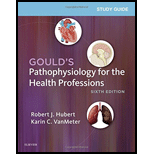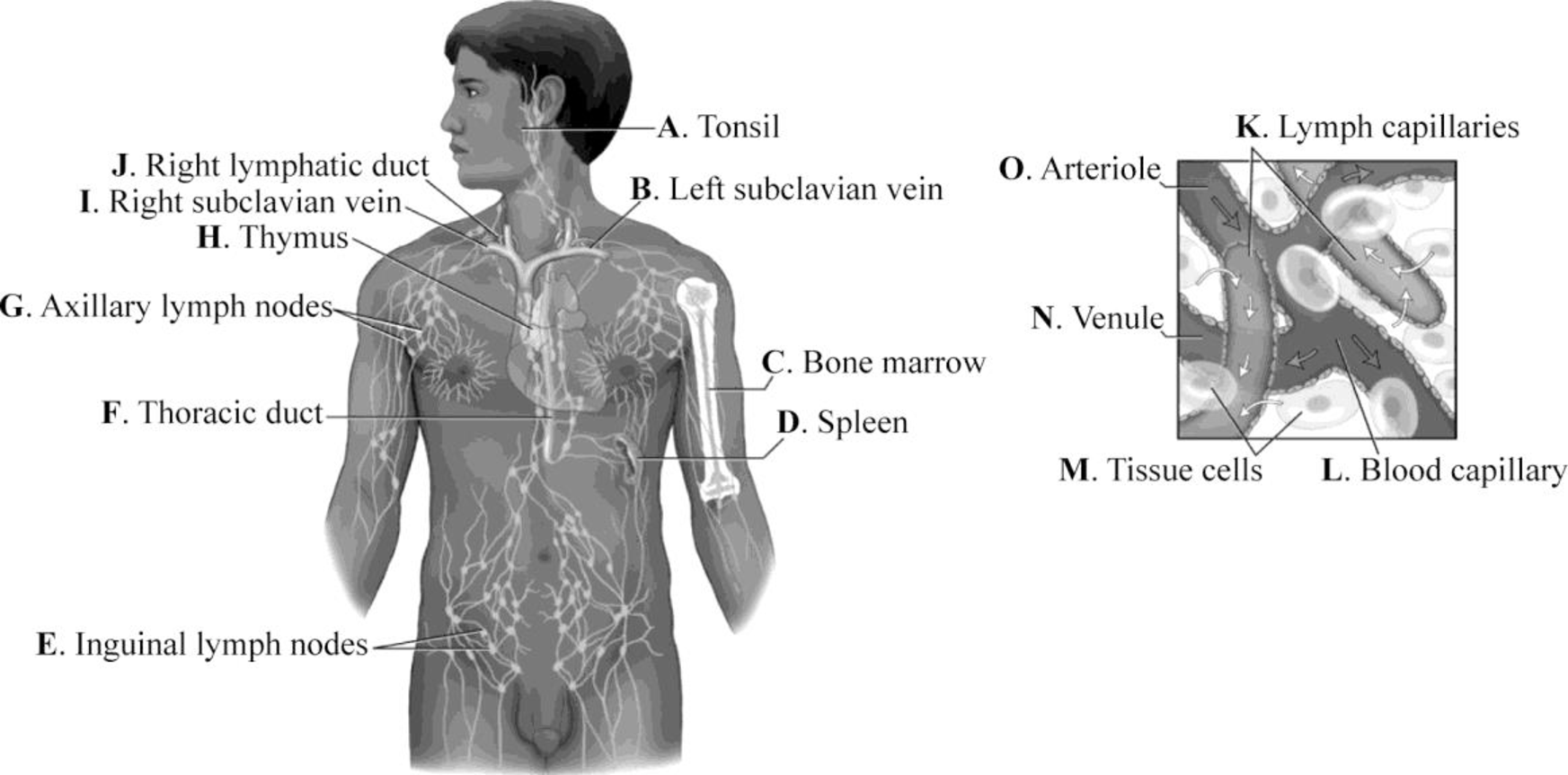
To match: The terms with the structures/organs of the lymphatic system in the given figure.
Introduction: A complex network of cells, tissues, and organs that work together to protect the body and fight against pathogens or foreign substances is collectively known as immune system. Lymphatic system consists of a network of vessels, tissue, and ducts that carry a clear fluid (lymph) to all body parts.
Answer to Problem 1P
Pictorial representation: Fig.1 shows the structures/organs of lymphatic system.

Fig.1: Lymphatic system
Explanation of Solution
Lymphatic system is an essential part of the immune system, which consists of lymphatic vessels and lymphoid tissue, which includes pharyngeal tonsils, palatine, spleen, lymph nodes, and thymus gland.
The structures/organs of the lymphatic system are given as follows:
A. Tonsil:
Tonsils are soft tissues found in the lymphatic system. The pharyngeal and palatine tonsils contain lymphoid tissue that is present at the back of the throat. The tonsils can serve as sentinels that protect the lungs and
B. Left subclavian vein:
A large blood vessel that arises from the axillary vein is called the subclavian vein. The left subclavian vein receives the thoracic duct.
C. Bone marrow:
The spongy tissue called bone marrow is present in the center of bones (cancellous or spongy). This organ is an important site for the production of blood cells (hematopoiesis). It is the major site where B lymphocytes mature.
D. Spleen:
Spleen is the secondary lymphoid organ. It is an organ that is present in the upper left part of the abdomen. It can serve as filters for blood. Spleen can also help to fight against the bacteria causing meningitis and pneumonia.
E. Inguinal lymph nodes:
Inguinal lymph nodes are the lymph nodes present in the groin (inguinal) region. These nodes are usually located below the inguinal ligament, which runs from the ilium's anterior superior iliac spine to the pubic bone's pubic tubercle. It is mainly classified as superficial lymph node and deep lymph node.
F. Thoracic duct:
The lymphatic system consists of two lymph ducts namely left and right lymphatic ducts. The largest lymphatic vessel inside the body is called as thoracic duct. It is also known as left lymphatic duct or alimentary duct. The thoracic duct drains the lymph into the blood stream near the brachiocephalic vein between the left subclavian and left internal jugular veins.
G. Axillary lymph nodes:
A type of lymph node is known as the axillary nodes, and they are located at the armpit (axillary) region of the body. These nodes are responsible for the lymphatic drainage of a large part of the human structure. They mainly perform filtration and conduction of lymph from the upper back, pectoral region, and upper back.
H. Thymus:
The thymus is the primary lymphoid organ. It is situated in the neck of vertebrates. Two identical lobes are found in the thymus. They are located in the anterior superior mediastinum behind the sternum and in front of the heart. The thymus plays a fundamental role in the mechanism of immunity against infections. Before birth, they are the final site for the development of lymphocytes. It secretes hormones after birth, which facilitates the formation of mature T-lymphocytes. These T-lymphocytes help to attack the foreign cells and act as regulators for the immune system.
I. Right subclavian vein:
A large blood vessel that arises from the axillary vein is called the subclavian vein. It is one of the deep veins of the neck. The right subclavian vein receives the right lymphatic duct.
J. Right lymphatic duct:
A lymph duct is a great lymphatic vessel that empties lymph into one of the subclavian veins. Right lymphatic duct and thoracic duct are the two main types of lymph duct. The right lymphatic duct drains lymphatic fluid from the right upper limb, right side of thorax, and right halves of head and neck.
K. Lymph capillaries:
Lymph capillaries are the tiny, thin-walled vessels that are located in the spaces between cells. It functions to drain and process the extra-cellular fluid. It has a greater internal oncotic pressure as they contain a higher concentration of plasma proteins in the lymph.
L. Blood capillaries:
Capillaries are the very small blood vessels that connect the arteries and venules. The important functions of the circulation occur mainly in the blood capillaries.
M. Tissue cells:
Tissues are groups of cells that have the same structure, and they work together to perform a specific function.
N. Venule:
A small-diameter blood vessel that branches out from the vein and leads to capillaries is called as a venule. Many venules connect together to form a vein. It has three layers namely the inner endothelium, the middle muscular layer, and the outer fibrous connective tissue. It allows the blood to flow from the capillary to large vessels (called veins) that carry deoxygenated blood from the body tissues to the heart.
O. Arteriole:
Arterioles are tiny branch of arteries that lead to capillaries. It regulates blood flow and blood pressure in the body under the control of the sympathetic nervous system.
Want to see more full solutions like this?
Chapter 11 Solutions
Study Guide for Gould's Pathophysiology for the Health Professions
- what causes a variation in vital signs and how can we make adjustments?arrow_forwardAnalyze the traits that define a profession that nursing has attained?arrow_forwardHello, Can you help me please with the next case: Assessment (Recognizing Cues) Which client information is relevant? What client data is most important? Which client information is of immediate concern? Consider signs and symptoms, lab work, client statements, H & P, and others. Consider subjective and objective data. Analysis (Analyzing Cues) Which client conditions are consistent with the cues? Do the cues support a particular client condition? What cues are a cause for concern? What other information would help to establish the significance of a cue? Analysis (Prioritizing Hypotheses) What explanations are most likely? What is the most serious explanation? What is the priority order for safe and effective care? In order of priority, identify the top 3 client conditions. Thank you in advnce!arrow_forward
- Adult Case 1: Day 2—Questions 1. Write the Day 2 PN bag using a 2-in-1 formulation. 2. Would you increase dextrose to goal? 3. Would you add/continue ILE on Day 2? Why or why not? If so, what amount? 4. Assess and determine electrolyte additives. Assess calcium–phosphate compatibility. 5. What other additives would you include in the Day 2 PN? 6. Are there any additional interventions you would make? 7. What follow-up laboratory test results might be important to obtain for tomorrow morning?arrow_forwardAnalyze the traits that define a profession that nursing has attained?arrow_forwardEvaluate ways nursing has failed to attain its status as a profession?arrow_forward
- Discuss the difference between an occupation and a profession?arrow_forward1. Write goal PN macronutrients using a 2-in-1 formulation. 2. What consideration for amino acid concentration needs to be assessed? 3. Would you start this patient on goal dextrose for Day 1? 4. Would you add ILE on Day 1? Why or why not? If so, what amount? 5. Assess and determine electrolyte additives. Assess calcium–phosphate compatibility. 6. What other additives would you include in the Day 1 PN?arrow_forwardWhat impact do regulatory and accreditation standards have on the risk management process within health care organizations? Why do you think it’s important to understand how regulatory and accreditation standards affect risk management? Provide examples.arrow_forward
- you are a school nurse. in the last2 weeks, 9 cases of head lice have been reported in four different classrooms. The potential for spread is high, and both parents and teachers are growing anxious. compose a memo for distribution to the teachers. your goals are to inform, reassure, and direct future inqueries.arrow_forwardasked but not answers yet Language of Medicine 13th edition chapter 1 sections A-E exercise with answers onlyarrow_forwardwhat are the different types of assessments in the nursing process and when are they performed?arrow_forward
 Phlebotomy EssentialsNursingISBN:9781451194524Author:Ruth McCall, Cathee M. Tankersley MT(ASCP)Publisher:JONES+BARTLETT PUBLISHERS, INC.
Phlebotomy EssentialsNursingISBN:9781451194524Author:Ruth McCall, Cathee M. Tankersley MT(ASCP)Publisher:JONES+BARTLETT PUBLISHERS, INC. Gould's Pathophysiology for the Health Profession...NursingISBN:9780323414425Author:Robert J Hubert BSPublisher:Saunders
Gould's Pathophysiology for the Health Profession...NursingISBN:9780323414425Author:Robert J Hubert BSPublisher:Saunders Fundamentals Of NursingNursingISBN:9781496362179Author:Taylor, Carol (carol R.), LYNN, Pamela (pamela Barbara), Bartlett, Jennifer L.Publisher:Wolters Kluwer,
Fundamentals Of NursingNursingISBN:9781496362179Author:Taylor, Carol (carol R.), LYNN, Pamela (pamela Barbara), Bartlett, Jennifer L.Publisher:Wolters Kluwer, Fundamentals of Nursing, 9eNursingISBN:9780323327404Author:Patricia A. Potter RN MSN PhD FAAN, Anne Griffin Perry RN EdD FAAN, Patricia Stockert RN BSN MS PhD, Amy Hall RN BSN MS PhD CNEPublisher:Elsevier Science
Fundamentals of Nursing, 9eNursingISBN:9780323327404Author:Patricia A. Potter RN MSN PhD FAAN, Anne Griffin Perry RN EdD FAAN, Patricia Stockert RN BSN MS PhD, Amy Hall RN BSN MS PhD CNEPublisher:Elsevier Science Study Guide for Gould's Pathophysiology for the H...NursingISBN:9780323414142Author:Hubert BS, Robert J; VanMeter PhD, Karin C.Publisher:Saunders
Study Guide for Gould's Pathophysiology for the H...NursingISBN:9780323414142Author:Hubert BS, Robert J; VanMeter PhD, Karin C.Publisher:Saunders Issues and Ethics in the Helping Professions (Min...NursingISBN:9781337406291Author:Gerald Corey, Marianne Schneider Corey, Cindy CoreyPublisher:Cengage Learning
Issues and Ethics in the Helping Professions (Min...NursingISBN:9781337406291Author:Gerald Corey, Marianne Schneider Corey, Cindy CoreyPublisher:Cengage Learning





